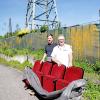A quarter of a century after the disaster, the fireworks are still in residential areas
/s3/static.nrc.nl/images/gn4/stripped/data132125071-39cc7f.jpg|https://images.nrc.nl/M-tD35RX6alzNVGh3gnvNjQN9Wk=/1920x/filters:no_upscale()/s3/static.nrc.nl/images/gn4/stripped/data132125071-39cc7f.jpg|https://images.nrc.nl/YCBJIUWiNCKgM8VsLNUqrM25Jek=/5760x/filters:no_upscale()/s3/static.nrc.nl/images/gn4/stripped/data132125071-39cc7f.jpg)
In the stately Burgerzaal of the town hall in Enschede, Mayor Roelof Bleker sees on Monday evening 3 February 2025 how sad and anger for priority fight in a presentation about the fireworks disaster at SE Fireworks. That no longer surprises him: it may be 25 years ago, many people are affected or know someone who is a victim.
On May 13, 2000, Bleker heard the three explosions that made the Roombeek district equal in his home in Enschede. Those sunny Spring Day lost 1,250 people their house, 947 people were injured and 23 people were killed, including four firefighters.
As a member of the Enschede city council for the PvdA, he was immediately confronted with the suffering of the victims. For the reconstruction of Roombeek, in which he was intensively involved as alderman for urban development, he had a lot of contact with the residents.
Roelof Bleker knows what he can expect if the results of a large investigation report on the disaster are presented on that evening in February. The emotions in Enschede are just below the surface and for some, distrust of the government is great.
How is that? What are the lessons of the fireworks disaster in Enschede? And why are some of them still not taken seriously?
According to the rules stored fireworks in residential areas, a heavy explosion can cause
What role did the central government play?
The presentation in the Burgerzaal is kicked off by René Torenvlied, professor of Public Administration at the University of Twente and Matthijs Moorskamp of Radboud University Nijmegen. Torenvlied is chairman of the committee that has conducted new research into the disaster on behalf of the House of Representatives from 2022.
The Chamber wanted the Torenvlied and his team committee specifically to look at the role of the central government at the disaster in Enschede. And in particular the question of what had been learned from an earlier fireworks disaster: in Culemborg in 1991. Hence the title of their report: Learning from two fireworks disasters.
In addition to those questions about the past, there are concern about the present at the Chamber. For example about the safety of storage of fireworks in residential areas and, another sensitive subject, about the instructions for the fire brigade in combating fireworks fires.
Torenvlied also has experience with the severe emotions that the firework file evokes in Enschede. What does not help is that his committee did not answer that one, ultimate question: how did the fire arise at SE Fireworks?
The mystery over ‘the first flame’ is an important source of doubt and distrust. After all the facts that has already been done, Torenvlied did not expect him to answer that question. That was not his assignment either.
But that does not detract from the sentiment in Enschede, it appears during the presentation. « How can I continue, if the truth is concealed? » Mathilde van der Molen asks rhetorically during the meeting. Her husband is one of the firefighters who died 25 years ago at the explosions in Enschede. She can’t really handle her loss without answers.
A warned man
René Torenvlied occasionally goes back to his bulky report in a meeting room of the University of Twente when he tells about his research and the questions that still live on it. He was a warned man when he started it: in a group directly or indirectly those involved, every government action raises resistance in advance. « Even if you do independent research on behalf of the parliament, » says Torenvlied.
The hard conclusions about the government do not change that. Torenvlied, for example, states that « the unsafe fireworks storage in the Netherlands was around 2000 » caused by poor coordination between the central government and municipalities involved in the granting of permits and fireworks companies and supervision thereof.
The research by Torenvlied also showed that the Ministry of Transport, Public Works and Water Management and that of public housing, spatial planning and the environment for the disaster in Enschede argued for years. That conflict was about the rules for storing professional fireworks by fireworks suppliers. The result was that at the time of the fireworks disaster in Enschede there were no guidelines « that regulated the interaction with, and storage of professional fireworks (s). »
Those conclusions feed distrust against the government. « The reaction is: » You see, they withheld information, « says Torenvlied. « The strange thing is that mistrust then also focuses against us. We too are, wrongly, being seen as an extension of the government because we have no answer to that one ultimate question: the cause of the disaster at SE Fireworks. »
Campaign
In Enschede it led to a struggle on the Torenvlied report, which was already offered to the Lower House at the end of 2023. It is the reason that it took more than a year before Torenvlied could present his findings in Enschede.
That delay was partly caused by one of the main characters in this file: Rudi Bakker, former owner of SE Fireworks. He filed a complaint at the university because the investigation would not meet the ethical standard. That complaint was rejected and also an attempt to stop the report through the judge did not succeed.
It fits in with the struggle for rehabilitation that Bakker conducts after his irrevocable conviction to one year in prison for death due to guilt in 2003. For example, in 2018 he seizes a report by MEP Paul van Buitenen for a request for revision at the Supreme Court. That was rejected.
Fireworks storage in residential areas
The Van Buiten report was a reason for the House of Representatives to ask Torenvlied to do new research. In addition to the role of the central government at the fireworks disasters in Culemborg and Enschede, there are also questions about fireworks storage at the room. Is that safe for the people who live in the neighborhood? And what about the safety of firefighters who have to extinguish a firework fire?
The answers from Torenvlied and his team to those questions are crystal clear: no, it is still not safe. It is one of the paradoxes of the fireworks disaster. The rules for the storage of ‘heavy’ professional fireworks have since been so strict that this has disappeared from the Netherlands. That fireworks are now in old bunkers in Germany and Belgium.
The rules for storing ‘light’ consumer fireworks have become less strict after the disaster in Enschede
The rules for storing ‘light’ consumer fireworks have become less strict after the disaster in Enschede. For example, there is a reporting obligation but no permit requirement. The idea is that this category of fireworks is not mass explosive, and in the event of a fire not exploding in one go, such as the fireworks at SE Fireworks. That is why the storage of a maximum of 10,000 kilos of consumer fireworks is still permitted in residential areas.
There are assumptions under that policy that, according to Torenvlied, are not always correct. « So -called light fireworks are more dangerous than was assumed. That has to do with a few complex technical issues. For example, the way in which fireworks is packed can have major consequences. And the classification of fireworks – there are four categories from light to heavy – is not always reliable.
It makes control very difficult in practice, says Torenvlied. According to the professor of Public Administration, this is because rules are being adjusted or not unambiguously interpreted.
In addition, fireworks do not always behave predictably in the event of a fire, says Torenvlied. « That means that consumer fireworks can behave ‘mass explosive’. That means that according to the rules stored fireworks can cause a heavy explosion because it explodes in one go. »
That conclusion has far -reaching consequences, given the disaster in Enschede: consumer fireworks are stored with the government’s approval in around four hundred residential areas throughout the Netherlands.
Administrative discord
In response to Torenvlied’s conclusions, the government adjusted the rules for the packaging of consumer fireworks in 2024. Certain packaging methods are phased out in consultation with the fireworks industry.
In addition, on behalf of State Secretary Chris Jansen (Infrastructure and Water Management, PVV), further research is being conducted into the unpredictable behavior of consumer fireworks. But according to The safety consultationthat speaks on behalf of the 25 safety regions in the Netherlands, that is not all enough.
For example, until the summer of this year, consumer fireworks are circulating in unsafe packaging. There is also an error in the Environment Act, which means that heavier, professional fireworks can also be stored in residential areas.
This conclusion has major consequences for the instruction for firefighters who have to extinguish a fireworks fire. Because consumer fireworks can also be mass-explosive, firefighters run great risks when extinguishing. That is why the instruction was adjusted after the Torenvlied report. « It is safe or it is not safe, » says the safety council. « There can be no light for the fire brigade. »
Photo Eric Brinkhorst
This means that, due to the plausible risk of a heavy explosion, firefighters must keep distance when extinguishing a fire at a location where consumer fireworks are stored. They cannot formally do much more than evacuating the neighborhood in such a situation.
But according to the Safety Council, that provides a devilish dilemma for fire brigade commanders. « During a fire at a fireworks storage, the necessity can arise – partly under pressure from the public – to go into this area at the risk of their own life to save people. »
Because there is still research, the government does not want to proceed at the moment, at the request of the Security Council, a ban on the storage of consumer fireworks in residential areas. And that refusal was a reason for mayor Roelof Bleker of the municipality of Enschede to climb into the pen.
That fireworks are much more dangerous than we always thought
After the presentation of Torenvlied in Enschede, Bleker has the cabinet by letter Asked to introduce measures to « guarantee the safe storage of (consumer) fireworks ». Bleker does not find the new extinguishing instruction for the fire brigade, « given the history of the city of Enschede. » In a fire in a residential area « people expect the fire brigade ».
He advocates an adjustment of the Environment Act, in which storage of fireworks can be regulated. But that will not happen now that there is a majority in the Lower House for a general fireworks ban, Bleker thinks. « I expect that the need for regulating the fireworks storage in residential areas will disappear. »
Professor Torenvlied thinks that the practical introduction of a fireworks ban can take another two years. Until that time, according to Torenvlied, the Netherlands accepts, despite all the research into the fireworks disaster at SE Fireworks, so the real risk of a fireworks explosion in a residential area: « That fireworks are much more dangerous than we always thought. »
Read also
His images of the fireworks disaster passed the world. As mayor he says: Be prepared for disasters

:format(webp)/s3/static.nrc.nl/wp-content/uploads/2025/05/12103452/data132098724-fbdd4f.jpg)
:format(webp)/s3/static.nrc.nl/images/gn4/stripped/data98480708-de61b6.jpg)
/s3/static.nrc.nl/images/gn4/data132134012-36b090.jpg)





